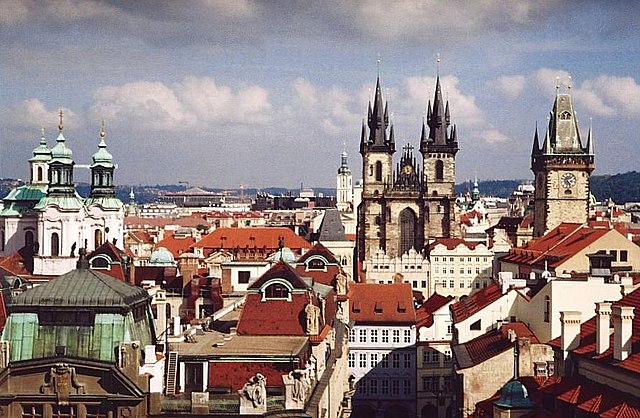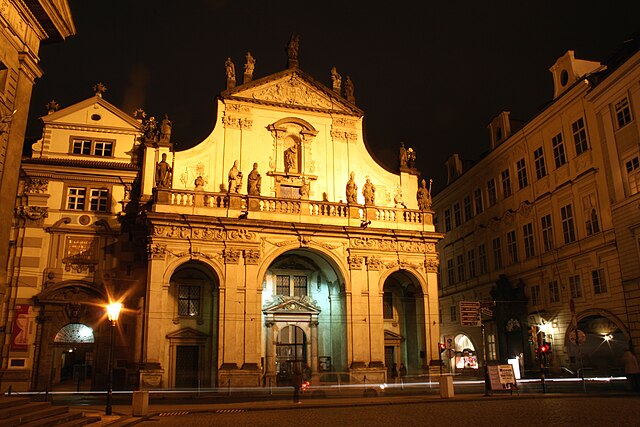Clementinum National Library, Prague, Czech Republic.

The National Library of the Czech Republic, known as the Clementinium, is known for its magical atmosphere.
The Clementinum is mentioned in The Secret Miracle, a short story by the Argentinian author Jorge Luis Borges. The main character of the story is a playwright named Jaromir Hladík who has been arrested by the Nazis in Prague during World War II. While under a death sentence, Hladík dreams of going to the Clementinum library, where one of the books contains God within a single letter on one of the pages. In an old atlas, Hladík touches a letter on a map of India and hears a voice saying he will be given the time he needs to write a play. Visitors can also appreciate the Clementinium in less dramatic circumstances, viewing its many rare books and illuminated manuscripts.
Early origins and legends.
The buildings making up the National Library originated with an 11th century chapel dedicated to Saint Clement of Rome. The library was founded in 1781. It is built in an energetic baroque style, and has been called a baroque pearl. There are other legends associated with the building, because in the 1400s a religious court was stationed in the Clementinium during the Inquisition. The Inquisition was part of the judicial system of the Roman Catholic Church to fight enemies of the church. According to surviving records, in 1414 in one of the courtyards of the Clementinium, heretics – or people who argued with the laws of the church – were burned alive. In the 1700s, a priest, Antonín Koniáš, was very determined to destroy all books that were not approved literature for Catholics, and he burned thousands of books from the Clementinium’s collection. To this day, Father Koniáš is known as the destroyer of Czech literature. With these types of incidents in its past, the Clementinium can seem to be a spooky place.

Administrative assistants who work in the accounting department of the library claim they have seen a ghost there. It is supposed to be the spirit of Saint Edmund Campion, an English Roman Catholic Jesuit priest from the 1500s. Campion studied at the Clementinium, where he got the idea to return to his native England and try to make the Protestant country Catholic. He failed, and was charged with treason and executed. Half a millennium later, he has supposedly returned to the Clementinum to scare the employees there, in order to express his unhappiness at the way things turned out. The people of Prague give a lot of thought to ghosts and in 2008 a new tourist attraction opened, the Ghost Museum of Prague Mysteriae Pragensia.
Honors and dangers.
In 2005, the library received the Jikji Prize from UNESCO through its Memory of the World Programme for digitizing precious old texts. The digitizing project started in 1992 and in the next 13 years, over 1,700 documents were digitized. It is good that some of the library’s best-loved possessions are preserved this way, since there have been some unfortunate accidents of weather and fire over the years. The library was affected by the 2002 European floods, and some documents had to be moved to upper levels to preserve them. In July 2011 more floods made it necessary to relocate more than 4,000 books to prevent them from being damaged. In December 2012, a fire broke out at the library, fortunately without harming people or property. The National Library has over 6.5 million volumes and each year, it acquires about 80 thousand new ones. More than one million visitors use the library yearly, borrowing around one million books. Any resident over the age of fifteen can get a library card.

Thailand and the Czech Republic
Last year, Thailand and the Czech Republic celebrated 40 years of diplomatic ties. Even before full diplomatic relations were established there were contacts between the Kingdom and what was then called Czechoslovakia. In 1934, His Majesty the King Prajadhipok, Rama VII, made an official visit to Czechoslovakia. In 1994, Czech President Václav Havel (1936-2011) came to Bangkok to meet His Majesty King Bhumibol Adulyadej, Rama IX. A dissident playwright who was known for his friendships with rock stars and other counter-culture types, Havel published a memoir in 2006, so far untranslated from the Czech original, in which he described his trip to Thailand. According to one review, in the book Havel
regrets he couldn’t see Bangkok’s erotic district because as a guest of the Thai King, that just wouldn’t be appropriate. And meanwhile, the rest of the Czech delegation, including the Minister of Finance, not only went to the seedy district, but had their photos taken there.
His Excellency Vítězslav Grepl, the current Czech ambassador to Thailand, told The BigChilli magazine that while he has already served as his country’s ambassador to Malaysia and China, he is finding new aspects of Asia to enjoy here in the Kingdom. In 1998, when he was stationed in Finland, Ambassador Grepl’s wife got tired of the long winter in northern Europe. She asked for a holiday in
a nice, and especially warm, place full of sun, greenery and colorful flowers. I suggested Thailand, and Thailand it was. It also was my first trip out of Europe. This trip was probably the decisive moment in my career. Ever since then I have been returning to Asia more so than Europe, and my family also began to associate their lives predominantly with this massive, vibrant and dynamic continent, which became the new center of gravity of our world.

Thais who are interested in the sport of tennis know about the Czech champions Ivan Lendl and Martina Navrátilová, and shopaholics are aware of Czech manufacturing products, including Bohemia Crystal and Škoda passenger cars. The Aero L-39 Albatros, a Czech jet trainer aircraft, is used by the Thai Air Force and Thai police personnel carry CZ pistols, likewise made in the Czech Republic. As Ambassador Grepl says:
Czech-Thai contacts go back quite far. Detailed information about the Kingdom of Siam was brought to the people of the Czech lands in the 17th century by Jesuit missionaries. After the establishment of the independent Czechoslovak Republic in 1918 economic relations started to flourish and Czech companies like Bata, Škoda and Zbrojovka Brno became strong in the region of Southeast Asia. In 1989, the year of democratic change in Czechoslovakia and the end of the communist regime, a new era of Czech-Thai relations began. Thailand soon became a favorite destination for Czech tourists and businessmen. The Czech and Thai governments launched numerous joint activities and a new basis for political relations was established.
When not working hard at his job, the ambassador enjoys playing ice hockey in Bangkok and cycling in Lumpini Park. Although there is plenty of room for more exchange and mutual acquaintance, the ambassador points out that
Today, tens of thousands of Czechs come to visit Thailand every year and the volume of trade is dynamically increasing on both sides. Relations between the two countries are developing successfully with no major obstacles. At the same time the Czech Republic has become known among many Thais as an interesting place to visit, and their number is increasing every year. According to my information and the Immigration Bureau of Thailand, altogether 32,928 Czech nationals visited Thailand in 2012. I haven’t got the final figures for 2013 but I expect a similar number of arrivals. As for Thais visiting the Czech Republic, the number was somewhere around 40,000 in 2013, which is approximately 10% more than in 2012. There are over 200 Czechs living in Thailand on a long-term basis, whereas around 700 Thais are currently staying in the Czech Republic. Our bilateral relations are extremely friendly and mutually advantageous. Thailand continues to be the largest trading partner of the Czech Republic among ASEAN member states and Czech companies regularly participate at trade fairs in Thailand. Thai companies take part at the International Engineering Fair in Brno, the biggest trade fair of its kind in Central Europe… There is cooperation in research and development and also student exchange programs. We are very happy that Thai students often choose universities in the Czech Republic. Many of them study under the Erasmus Mundus Programme. And on the other hand young Czechs also come to study at universities in Thailand.
(all images courtesy of Wikimedia Commons)

